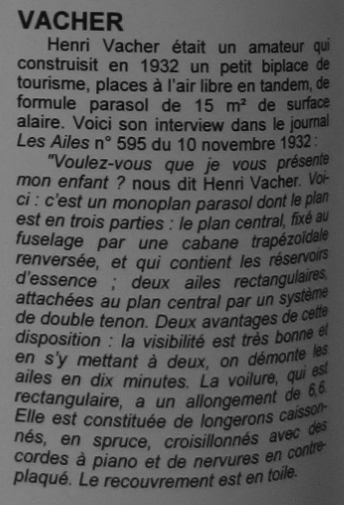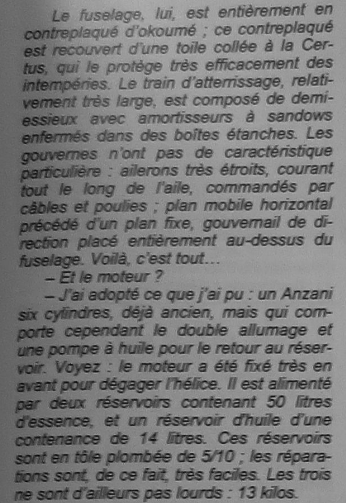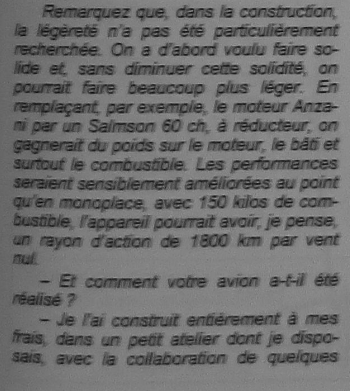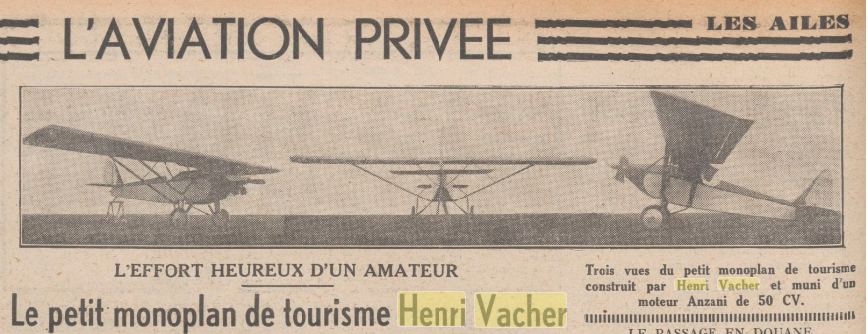- Joined
- 26 May 2006
- Messages
- 34,946
- Reaction score
- 15,838
I found this about him ?,from far left.Mainguet
I found this about him ?,from far left.Mainguet
Was that the same person ?.Viratelle was a monoplane Project of 1929
Vacher







![Les_Ailes___journal_hebdomadaire_[...]_bpt6k65601917_8.jpeg](/data/attachments/184/184463-81342ac8406dc863929d7fe5f334238a.jpg)
![Les_Ailes___journal_hebdomadaire_[...]_bpt6k6555890h_13.jpeg](/data/attachments/184/184464-d4044bd3183f23699a590cee2512dc51.jpg)
From Aerohpile 1934.The Moineau biplane was designed and built by MM Bessard & Millevoye at Saint-Ouen in 1935. The drawing above, together with a detailed review of this aeroplane, can be found in Les Ailes of 15 August 1935. The name 'Le Moineau' appears on its fuselage in the accompanying photograph.
Mr. Botty designed an experimental airplane in 1920,no more details are known.
From Aerophile 1920,there was unknown airplane from 1920,designed by Dubois-Piquet,any idea ?.
Some missing solutions. - Above, from left to right:
Tailless plane.
From TU 166.Hi,
here is a tailless airplane,designed by A. Bonnel,appeared in 1939.
Ailes 1/1946
From TU 169,hesham said:
This designer,Carmier,also had some unbuilt Projects,such as a two-seat low-wing sporting monoplane.
From Aerophile 1923,more Info.Mr. Charles Boishard designed a motorcycle powered ultra light monoplane in 1923;
From, Special Types of Rotary Wing Aircraft - Volume 11,From TU 226,
Mr. Henri Le Boloch designed a system for Brake Flaps in 1920,followed by Lift Machine with a propellers,and
a Helicopter in 1934/35,we spoke about him before here;
The first is the subject of the patent 526,166 filed February 20, 1920 and which relates to lower shutters, in fact
brake flaps.
In 1934, he proposed a system lift based on an original principle. A small diameter propeller special shape, the
profile not including than an attack spout with no back surface,rotates horizontally at very high speed flush with
a flat surface. To the very high rotational speeds, the air streams, violently spread by the edge of the propeller
as by a projectile, cannot close immediately behind her. The result is the formation of an intense and remarkably extensive depression. Air nets,by folding back, draw in some so the profile of least resistance determined by the
leading edge.
Such a propeller, even in rotation very fast in the open air, would not lead to no practical results; but, and there it
is the crux of this invention, if this rotation takes place flush with a horizontal plane surface, this surface harvest all
the benefit of the area intense pressure, in the form of a vertical thrust. Of course, the contact must be intimate to compel all the air streams to pass through the upper surface.,it suffices to coat the surface plane with a simple film
of oil very viscous,this device therefore consists of get a pressure difference between the upper part of the plane on which turns the propeller which lifts the column of air at each pass, and the lower part on which is exerted without
constrains atmospheric pressure. The result must be a lifting force.
To roughly quantify, we can say that if the total vacuum existed on the surface swept by the propeller, we would
obtain a force of 10,000 kg per meter square. Like the depression area is only one fifth of the swept area and
admitting 50% of all orders, we arrive at 1000 kg per meter square of swept area.
Editor does not know if work were conducted on the basis of this idea, but in 1935, it was announced that Le Boloch
is studying a helicopter at Saint-Cyr in collaboration with Mr. Toussaint.
It seems there is a mistake in the length (longueur) in article. According to the scheme, the length should be not 5,1, but 5,4 meters.The Moineau biplane was designed and built by MM Bessard & Millevoye at Saint-Ouen in 1935. The drawing above can be found in Les Ailes of 15 August 1935 p.3
From TU 164,Mr. F. Brun,Hi,
does anyone know a more Info about Mr. Brun Avionnette or ultra-light airplane of 1935 ?.
From TU 193,Hi,
does anyone hear about Bonneville seaplane aircraft of 1919
From TU 193,and anther sources;Hi,
Mr. Maurice Drouhin was a well known pilot,but he designed also
airplane,who heard about it ?.
From TU 194,In TU magazine, they spoke about Mr. Ducceschi who designed an airplane in 1934, but when I search on it in Ailes, I can't understand what was it ?.
Nothing to do with aircraft. M. Ducceschi was proposing the use of large-diameter fans to drive 'asphyxiating gases' (smog, pollution, natural gas fumes?) away from Algiers. These large-bladed fans would be powered by aero-engines of 400-to-500 hp. That seems to be the only aviation connection. (The article ends voicing a concern that Ducceschi's concept may serve to displace the noxious gases without actually dissipating these pollutants.)
Obviously, any avion developed by Ducceschi in 1934 was utterly unrelated to his Algiers proposal (assuming this is the same Ducceschi). Alternatively, Trait d'Union was equally misled by Ducceschi's mention of aero-engines for his pollution project.
'Its future [fate?] is unknown to the editor'From TU 194,
His becoming is unknown to the editor.
More Info from TU 206,Hi,
also the Filleul box-wing pusher light aircraft project;
http://gallica.bnf.fr/ark:/12148/bpt6k65605157/f9.i
In French it means: Sweep and forward-sweep.Can a native speaker confirm on flèche and contre-flèche?
In French it means: Sweep and forward-sweep.Can a native speaker confirm on flèche and contre-flèche?
The box wing's structure is one spar swept back and one spar swept forward (counter-swept in that journo's parlance)
TU 271 talks about Nieuport aircraft with the designation NiD.320, Nie.130 and Loire-Nieuport LN.80 (LN.21). Do any of you have drawings or illustrations of these planes?
I think those drawings were belonged to he same guy,Mr. Mallet ?.From TU 262,
here is a Helicoplane,designed by Mr. Mallet.
